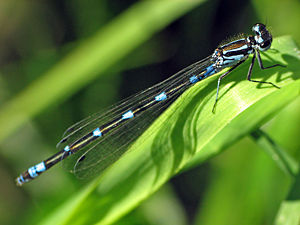Damselfly: Difference between revisions
Jump to navigation
Jump to search

imported>Igor Grešovnik No edit summary |
imported>Meg Taylor (move contents to subgroup) |
||
| (2 intermediate revisions by 2 users not shown) | |||
| Line 37: | Line 37: | ||
*†[[Zacallitidae]] | *†[[Zacallitidae]] | ||
}} | }} | ||
{{Image|C - Coenagrion puella - Azure Damselfly male - IG - 08 07 12 crnece 098.jpg|right|350px| A damselfly (species Coenagrion puella) eating its catch on a leaf.}} | |||
'''Damselfly''' is the an [[insect]] of the Suborder ''[[Zygoptera]]'' in the order [[Odonata]]. It is characterized by an elongated body, two pairs of wings with hindwing being essentially similar to the forewing, and large, separated [[Eye#Compound_Eyes|multifaceted eyes]]. In most species, the wings are held along the body when at rest, which distinguishes damseflies from [[dragonfly|dragonflies]]. Damselflies are also usually smaller (in particular with notably thinner [[abdomen]]) and weaker fliers than dragonflies. | '''Damselfly''' is the an [[insect]] of the Suborder ''[[Zygoptera]]'' in the order [[Odonata]]. It is characterized by an elongated body, two pairs of wings with hindwing being essentially similar to the forewing, and large, separated [[Eye#Compound_Eyes|multifaceted eyes]]. In most species, the wings are held along the body when at rest, which distinguishes damseflies from [[dragonfly|dragonflies]]. Damselflies are also usually smaller (in particular with notably thinner [[abdomen]]) and weaker fliers than dragonflies. | ||
| Line 52: | Line 51: | ||
===Eggs=== | ===Eggs=== | ||
===Larvae=== | ===Larvae=== | ||
===Adults=== | ===Adults=== | ||
==Taxonomy== | ==Taxonomy== | ||
| Line 63: | Line 60: | ||
==See also== | ==See also== | ||
Latest revision as of 21:58, 14 September 2013
| Damselfly | ||||||||||||||||
|---|---|---|---|---|---|---|---|---|---|---|---|---|---|---|---|---|
 (CC) Photo: Marko Kivelä
Common Blue Damselfly (Enallagma cyathigerum) | ||||||||||||||||
| Scientific classification | ||||||||||||||||
| ||||||||||||||||
| Families | ||||||||||||||||
|
Damselfly is the an insect of the Suborder Zygoptera in the order Odonata. It is characterized by an elongated body, two pairs of wings with hindwing being essentially similar to the forewing, and large, separated multifaceted eyes. In most species, the wings are held along the body when at rest, which distinguishes damseflies from dragonflies. Damselflies are also usually smaller (in particular with notably thinner abdomen) and weaker fliers than dragonflies.
